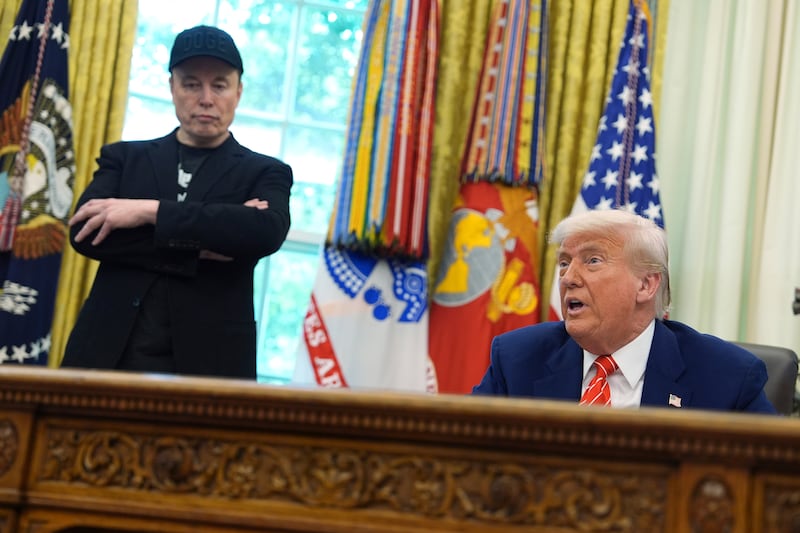- President Trump increased steel and aluminum import tariffs to 50%.
- The increase comes amid re-escalating trade tensions between U.S. and China.
- Trump's tariff strategy faces legal challenges in federal court.
President Donald Trump followed through on a promise made last week to double the current 25% tariff rate on steel and aluminum imports, a move he says will help bolster a beleaguered U.S. manufacturing base.
Trump made the increase official in a proclamation that raised the trade levies on most steel and aluminum imports to 50% as of 12:01 a.m. EDT Wednesday. The president signaled the move in a speech delivered last Friday in Pennsylvania to an audience mostly of steelworkers.
Economists say the import fees are likely to fuel higher prices for construction, automobiles, appliances and other products though it may take months for the impacts to be felt.
White House spokesman Kush Desai said the tariff increase is just one part of a bigger Trump plan aimed at bolstering the domestic economy.
“Domestic steel and aluminum production is imperative for our defense-industrial base,” Desai said in a statement to CNN. “The Trump administration is committed to reshoring manufacturing that’s critical for our national and economic security while unleashing a full suite of supply-side reforms — including rapid deregulation, tax cuts, and unleashing American energy — to continue delivering economic relief for the American people.”
UK steel and aluminum exports to the U.S. were exempted from the new levies thanks to a trade deal between the two countries announced on May 8. But Trump said the 50% fee could be extended to the UK after July 9 if the White House “determines that the United Kingdom has not complied with relevant aspects” of the agreement, per CNBC.
Wednesday also marks the deadline for U.S. trading partners to provide their best offer on trade negotiations as Trump’s international trade representatives seek to accelerate talks with multiple partners ahead of a self-imposed deadline in just five weeks, according to a draft letter to negotiating partners seen by Reuters.
In the draft, the U.S. is asking countries to list their best proposals in a number of key areas, including tariff and quota offers for purchase of U.S. industrial and agricultural products and plans to remedy any non-tariff barriers.
U.S.-China trade war heating up again
Trump’s new tariff decree, which doubles a 25% import fee on steel and aluminum first imposed on March 12, comes as trade tensions between the U.S. and China appear to be re-escalating, with both countries claiming in recent days that the other is in violation of an agreement reached last month.
Earlier this week, China hit back on Trump’s claims the Asian country was in breach of a new trade agreement, struck last month following talks held in Geneva, Switzerland, countering that the U.S. itself was undermining the deal with new sanctions.
A statement from China’s Ministry of Commerce released Monday said Trump administration actions “seriously undermine the existing consensus reached at the Geneva economic and trade talks, and seriously damage China’s legitimate rights and interests.” Chinese officials also pointed to recent signaling from the U.S. about potential new regulations for advanced microchips and the revocation of U.S. visas for Chinese students, per CBS News, as evidence that the U.S. was acting in bad faith following the trade deal.
In Truth Social post last Friday, Trump said that the deal had led to greater economic stability for China and “everybody was happy” but alluded to China violating terms of the agreement.
“The bad news is that China, perhaps not surprisingly to some, HAS TOTALLY VIOLATED ITS AGREEMENT WITH US. So much for being Mr. NICE GUY!” Trump wrote.
Trump’s tariff strategy is also facing legal scrutiny.
What the courts are saying about Trump tariffs
In a ruling issued last Wednesday, the U.S. Court of International Trade struck down a wide swath of trade tariff decrees made by Trump since he took office, finding the president overstepped his authority with the international levies.
But a day later, the U.S. Court of Appeals for the Federal Circuit granted a temporary hold on the lower court ruling, deciding that the “permanent injunctions entered by the Court of International Trade in these cases are temporarily stayed until further notice while this court considers the motions papers.”
Per the appeals court, the plaintiffs in the lower court case have until June 5 to respond to the stay decision and Trump’s legal team will have until June 9 to develop its argument for the pause to remain in place as the appeals process plays out.
The trade court ruling, should it stand, impacts new tariffs Trump has issued, without congressional approval, under the International Emergency Economic Powers Act. The decision would not impact sector-specific tariffs issued by the president including those on imported autos, auto parts, steel and aluminum.


